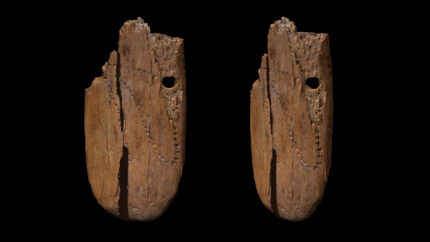An ivory plaque decorated with a curve of incised dots is the oldest known punctate ornament discovered in Eurasia. Advanced in radiocarbon dating have made it possible to directly date the mammoth ivory pendant to 41,500 years ago, which predates by at least 1,500 years the previous understanding of when decorated ivory pendants began to be produced by the earliest Homo sapiens to arrive in Europe.
“It is the oldest known [jewelry] of its kind in Eurasia and it establishes a new starting date for a tradition directly connected to the spread of modern Homo sapiens in Europe,” the researchers wrote in the study.
The pendant was likely worn around someone’s neck, but we can’t be certain, said study lead researcher Sahra Talamo, a chemistry professor at the University of Bologna in Italy, who specializes in human evolution and radiocarbon dating.
The researchers noted that the pendant was created at a time when anatomically modern humans were first developing jewelry and other forms of body adornment around the world. Why humans started using jewelry at this time is a mystery that researchers are trying to understand, Talamo said.
There are very few man-made pendants made from animal ivory older than this. Some simple pierced animal teeth and mammoth ivory engraved with ]geometric line patterns were produced by Homo sapiens as they began to spread over the continent. The aligned punctuations were a new type of decoration. Other examples of this type of decoration found in southern France and Germany have not been absolutely dated; their chronological attribution is based on stratigraphy as recorded in excavations from the early 1900s, which is less than precise compared to modern methodologies.
The pendant was found in the Paleolithic layers at Stajnia Cave in Poland in 2010. Broken into two pieces, it was originally a small oval just 4.5 cm high, 1.5 cm wide and 4 mm thick (1.8″ x .6″ x .16″). It is pierced through by two drilled holes and decorated with at least 50 sequential puncture marks that form an irregular curve. The dots could signify something, a calendar for example, or a headcount of hunted animals, or they could be an abstract natural pattern, like a leopard spot.
The study was published in Scientific Reports and can be read in its entirety here.
